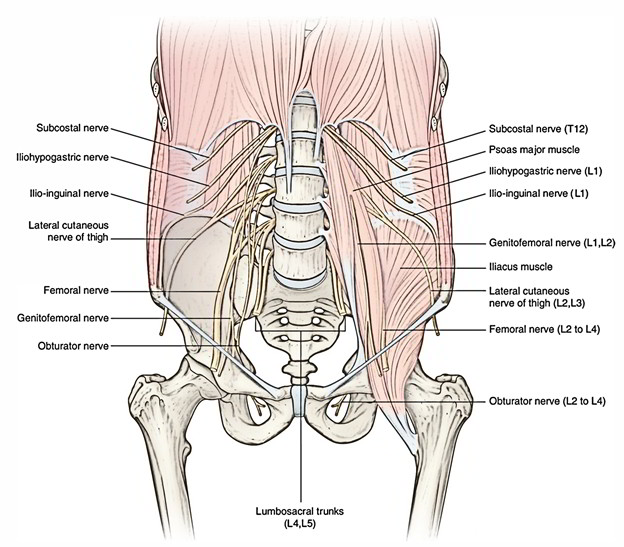Genitofemoral nerve originates from the LI and L2 ventral rami, the genitofemoral nerve is formed within the matter of psoas major. Opposite the third or fourth lumbar vertebra, genitofemoral nerve goes down obliquely via the muscle to emerge on its medial border. It then goes down below the peritoneum on the psoas major, intercrosses obliquely behind the ureter, and splits above the inguinal ligament into genital and femoral branches. The genitofemoral nerve typically splits near its origin, where case its branches emerge individually from the psoas major.
Origin
Genitofemoral nerve enters downward in the matter of the psoas major muscle till it emerges on the anterior surface of the psoas major. The genitofemoral nerve emerges from the anterior rami of nerves LI and L2. Then the genitofemoral nerve descends on the surface of the muscle, in a retroperitoneal position, enter posterior to the ureter. It ultimately splits into genital and femoral branches.

Genitofemoral Nerve: Origin
Insertion and Fucntions
- The genital branch continues down and goes into the inguinal canal via the deep inguinal ring.
- It continues via the canal and supplies the cremasteric muscle and terminates on the skin in the upper anterior part of the scrotum in men.
- In women, follows the round ligament of the uterus and ends on the skin of the mons pubis and labium majus.
- It enters the anterior layer of the femoral sheath and the fascia lata to supply the skin of the upper anterior thigh.
- The femoral division goes down on the lateral side of the external iliac artery and enter posterior to the inguinal ligament, going into the femoral sheath lateral to the femoral artery.
Branches
The genitofemoral nerve typically splits near its origin, where case its branches arise individually from the psoas major.
Genital Branch
The genital branch innervates the genital area. It provides the cremaster and the skin of the scrotum in males. In women, it accompanies the round ligament and ends in the skin of the mons pubis and labium majus. It intercrosses the lower part of the external iliac artery and goes into the inguinal canal by the deep ring.
Femoral Branch
The femoral branch supplies sensory innervation to the medial upper thigh and the skin over the femoral vessels. It goes down lateral to the external iliac artery, enter behind the inguinal ligament. It then goes into the femoral sheath lateral to the femoral artery. It enters the anterior layer of the femoral sheath and fascia lata and supplies the skin anterior to the upper part of the femoral triangle. It gets in touch with the femoral intermoderate cutaneous nerve and supplies the femoral artery.
Clinical Significance
Genitofemoral Neuralgia
- Genitofemoral neuralgia is among the most common reasons for lower abdominal and pelvic pain seen in clinical practice.
- Genitofemoral neuralgia might be triggered by compression of or damage to the genitofemoral nerve anywhere along its path.
- Pain might be described groin (accompanying genital branch) and inner thigh (along femoral branch).
- Pain is seen over lower abdomen mainly unilateral, very hardly ever bilateral.
- Most common reason for pain is damaged nerve in inguinal canal after inguinal hernia fixing.
- Pain is extreme sometimes with extension of lower back or palpation of groin over inguinal region.

 (58 votes, average: 4.66 out of 5)
(58 votes, average: 4.66 out of 5)